If youre going to bake a pie, its imperative that your crust be the star of the show. A pie with a melt-in-your-mouth perfect pie crust will make any pie so much better! Want to know Great Grandmas secret ingredient to perfectly flaky crust? Keep reading and youll too have perfect crust every single time WITHOUT using lard or shortening (talking Crisco).
Many people think you need to use lard or shortening in order to get a flaky, melt-in-your-mouth pie crust. But you DONT! My Great-Grandma shared her tips with me for getting the best crust every time, and theres a secret ingredient that most recipes are missing.
This recipe uses butter or lard (but coconut oil works equally as well) and is a foolproof recipe for flaky pie crust that rolls out easily every time.
Let me ask you this… do you ever eat a pie and fork out the filling, leaving the crust behind? Because if you said yes, you, my friend, have been using the wrong recipe.
In less than 15 minutes you can have 4 crusts (this a double pie crust recipe, meaning youll have enough crust for 2 tops and 2 bottoms of an 8 or 9-inch pie plate, or 4 crusts for cream or pumpkin pies) ready to bake or freeze.
This crust is so delicious, youll be leaving the filling just to eat the crust! In fact, my seven-year-old did that tonight.
When I was little, we made the hour trip to go visit my great-grandmother. We didnt get to go very often, but I remember her house and beautiful rose bushes even though I was quite young. My mother is an excellent baker and cook, but I never liked pie crust. Until I tasted this one. I had never eaten pie crust before and when I ate the entire piece of pie, crust included, my mom switched her recipe as fast as my great-grandmother could write it out.
Now Im thrilled to share it with you. Be warned, this flaky pastry pie crust recipe is the best Ive ever had. Like melt-in-your-mouth, going to eat the entire thing in one sitting so grab a big ol fork, good!
Are you looking for a pie crust recipe without shortening (aka Crisco)? If youre concerned about GMO foods and ones that are highly processed, then the answer is yes. I cut shortening out of our kitchen after a cancer scare almost ten years ago and have never looked back.
This recipe became my no-fail flaky pie crust with butter because, lets face it, real butter just makes everything taste better (especially grass-fed butter!). For real, Ive even been known to slip some butter into my coffee. And contrary to popular notions, Ive not packed on the pounds.
Should I use butter or lard in my pie crust? The truth is, either one works fine. I find that half butter and half lard make a perfect crust, and if Ive been “pioneering” then I usually have some homemade lard in the cupboard.
But for those of you who havent quite crossed that bridge yet, using all butter works just as well (and is what Im demonstrating in the video above).
Note: In order to achieve a flaky crust, your lard, butter, or coconut oil needs to be cold. Its the pieces of solid fat distributed throughout the flour which melt upon baking that create the flakiness.
Hey there baking buds! If you’re on the hunt for a pie crust that’s all kinds of flaky and delicious but don’t wanna mess with shortening you’ve landed in the right spot. I’m here to spill the beans on how to whip up a pie crust without shortening that’ll have everyone at the table begging for seconds. Whether you’re dodging processed fats for health reasons or just wanna switch things up with a richer taste, I’ve got your back with a recipe that’s easy-peasy and dang good.
We’re gonna dive into using butter as the star of the show—trust me, it brings a flavor punch shortening can’t touch. Plus, I’ll toss in some other options if butter ain’t your jam, along with tips to nail that perfect crust every time. So, grab your rolling pin, and let’s get this party started!
Why Skip Shortening? Let’s Break It Down
Before we get our hands dirty let’s chat about why you might wanna ditch shortening. Don’t get me wrong, shortening’s got its perks—it’s ace at making crusts super flaky ‘cause it don’t melt as quick as other fats. But here’s the rub it’s often loaded with trans fats or just lacks that homemade, buttery vibe I crave in a pie. Some folks also just don’t keep it in the pantry, or maybe you’re aiming for a more natural ingredient list. Whatever your reason, we’re sidestepping it today.
The trick with a pie crust is getting that tender, flaky texture, and shortening usually helps by creating little pockets of fat that turn into layers when baked Without it, we gotta be smart about our fat choice to get the same—or better—results That’s where butter struts in, and lemme tell ya, it’s a game-changer for taste. We’ll also peek at options like oil or lard if you’re curious, but butter’s my go-to for a reason.
My Go-To Pie Crust Without Shortening Recipe (Butter-Based)
Alright, let’s cut to the chase and make this crust. This recipe yields two crusts—perfect for a double-crust pie or saving one for later. It’s all about keeping things cold and working quick, so your fat don’t melt before it hits the oven. Here’s how I do it:
-
Ingredients (for 2 crusts):
- 2 ½ cups all-purpose flour, plus a lil’ extra for dusting
- 1 teaspoon salt (I like kosher, but table salt works)
- 1 cup (2 sticks) unsalted butter, super cold and cut into small cubes
- 6-8 tablespoons ice water (keep it chilly!)
- 1 teaspoon vinegar (apple cider or white, helps with tenderness)
-
Tools You’ll Need:
- Big mixing bowl
- Pastry cutter (or just use your fingers, no shame)
- Measuring cups and spoons
- Rolling pin
- Pie plate (metal’s my fave, but use whatcha got)
-
Steps to Glory:
- Mix Dry Stuff: In that big bowl, toss together the flour and salt. Give it a quick stir to blend.
- Cut in Butter: Add them cold butter cubes. Using a pastry cutter—or your fingertips if you’re old-school—work the butter into the flour ‘til it looks like coarse crumbs. You want pea-sized bits of butter; don’t overdo it, we need them chunks for flakiness.
- Add Liquids: Mix the vinegar into your ice water. Sprinkle in the water, a tablespoon at a time, stirring gently with a fork. Stop when the dough just holds together when you squeeze it. Too much water, and it’s gonna be tough, ya hear?
- Chill Out: Divide the dough into two equal balls. Flatten ‘em into disks, wrap in plastic, and pop in the fridge for at least 30 minutes. Cold dough rolls better and bakes flakier.
- Roll It: On a floured surface, roll out one disk from the center outward. Go gentle, don’t manhandle it. Aim for it to be a couple inches bigger than your pie plate.
- Fit It: Lift the dough into your pie plate—use a spatula if it sticks. Settle it in without stretching, trim the edges if needed, and tuck or crimp however you fancy.
- Bake or Fill: If your recipe calls for a pre-baked crust, poke some holes with a fork and bake at 375°F for about 12-15 minutes with pie weights (or dry beans) to keep it from puffing. Otherwise, fill it up with your pie goodies and bake as directed.
There ya go! A buttery, flaky pie crust without a lick of shortening. I swear, the smell of butter baking is worth the extra elbow grease of keeping it cold.
What Makes Butter So Special for Pie Crust?
Now, you might be wonderin’, why butter over shortening? Well, lemme lay it out. Butter’s got water in it, which turns to steam in the oven and creates them gorgeous flaky layers. Plus, the flavor—oh man, it’s like a warm hug compared to shortening’s kinda neutral taste. The catch? Butter melts faster, so you gotta work quick and keep everything cold as heck. I’m talkin’ chill your bowl if it’s a hot day, folks.
Here’s a quick cheat sheet on butter vs. shortening for pie crusts:
| Aspect | Butter | Shortening |
|---|---|---|
| Flavor | Rich, creamy, homemade vibe | Pretty bland, no real taste |
| Texture | Super flaky if kept cold | Flaky and easy to work with |
| Ease of Use | Trickier, melts quick | Stays solid, forgiving |
| Health Factor | Natural, but high in fat | Often has trans fats, processed |
So, while butter takes a bit more care, I reckon the taste payoff is worth it every dang time.
Other Fats to Swap for Shortening (If Butter Ain’t Your Thing)
Butter’s my ride-or-die, but maybe you’re lookin’ for somethin’ else. No worries, we got options for pie crust without shortening that still rock. Here’s the lowdown on a few:
- Lard: This is old-school, y’all. Lard’s got a high fat content and makes a crust that’s tender as can be. It’s got a slight savory kick, which pairs awesome with meat pies or quiches. Use it just like butter—keep it cold, cut it in, same deal. If you’re cool with animal fats, give it a whirl.
- Coconut Oil: For my vegan pals or those dodging dairy, coconut oil’s a solid pick—pun intended! It works best when chilled hard, so pop it in the fridge first. It can give a subtle tropical vibe to the crust, which might be neat for fruit pies. Use about ¾ cup for a double crust recipe.
- Vegetable Oil: This one’s a bit of a curveball, but it works for a softer, more crumbly crust. You don’t cut it in like solid fats; just mix it with the flour ‘til it’s damp, then add water. It’s less flaky but super easy if you’re in a pinch. About ½ cup per double crust does the trick.
- Vegan Butter: If you’re skipping dairy and animal stuff altogether, grab some plant-based butter. It behaves a lot like regular butter, just check the label to make sure it’s got enough fat content (some are too watery). Keep it cold and follow the same steps.
Each of these swaps changes the game a bit—texture or taste-wise—so play around and see what floats your boat. I’ve tried ‘em all at some point, and while butter’s my heart, coconut oil was a fun surprise for a tropical pie once.
Tools That Make Pie Crust a Breeze
You don’t need a fancy kitchen to pull this off, but a few gizmos can save ya some grief. Here’s what I keep handy:
- Pastry Cutter: This lil’ tool cuts fat into flour like a dream. Fingers work too, but this keeps things quick and cool.
- Rolling Pin: Obvious, right? I got a wooden one that’s heavy enough to flatten dough without much muscle.
- Pie Plate: Metal ones heat up even and help the bottom crisp. Glass looks pretty but can sog out the crust sometimes.
- Mixing Bowl: Big enough to toss everything without spillin’. Chill it if your kitchen’s toasty.
If you ain’t got these, no sweat—improvise with forks or whatever’s around. I’ve rolled dough with a wine bottle in a pinch, and it worked just fine, ha!
Tips to Nail Your Pie Crust Every Time
Making pie crust without shortening can feel like a tightrope walk sometimes, but I’ve got some tricks up my sleeve to keep ya steady. These come from years of trial and error—yep, I’ve had my share of crust disasters!
- Keep It Cold, Y’all: I can’t stress this enough. Cold butter, cold water, even cold hands if you can manage. Warm fat melts into the flour too soon, and you lose them flaky layers. I stick my butter in the freezer for 10 minutes before starting.
- Don’t Overwork It: Mix just ‘til it comes together. If you knead it like bread, you’re gonna get a tough, chewy mess. Be gentle, like you’re petting a kitten.
- Flour Your Surface: Rolling dough that sticks to the counter is a nightmare. Sprinkle flour generously under and on top of the dough. If it starts sticking, lift it with a spatula and add more.
- Chill Before Baking: Even after rolling, pop the crust in the fridge for 15 minutes if you got time. It helps it hold shape in the oven.
- Vinegar Trick: That splash of vinegar in the recipe? It tenderizes the dough by slowing gluten development. Don’t skip it—makes a big diff.
One time, I forgot to chill my dough, and it shrunk like crazy in the oven. Looked like a sad lil’ pancake. Lesson learned—patience pays off!
Troubleshooting: When Your Pie Crust Goes Wonky
Even with the best plans, pie crusts can throw curveballs. Here’s how to fix some common oopsies:
- Crust Falls Apart: Too dry, prob’ly. Sprinkle a bit more ice water, just a teaspoon at a time, ‘til it holds. Don’t go overboard or it’ll be gluey.
- Tough Crust: Overmixed or too much water. Next time, ease up on the stirring and measure liquids careful. For now, roll it thin and hope for the best.
- Soggy Bottom: Didn’t bake long enough, or your filling’s too wet. Blind bake (pre-bake) the crust with weights for 10-12 minutes before filling. Also, brush it with a beaten egg white before adding filling—it seals it up nice.
- Shrinking Edges: Dough got stretched when you put it in the pan, or it wasn’t chilled. Let it settle naturally into the plate next time, no pulling, and always chill.
I’ve botched plenty of crusts, believe me. Once had a bottom so soggy, it was basically pie soup. Blind baking saved my bacon after that fiasco.
Variations for Special Diets or Flavors
Wanna switch things up or got dietary needs? Pie crust without shortening can adapt like a champ. Here’s some ideas I’ve fiddled with:
- Gluten-Free Crust: Swap regular flour for a gluten-free blend. Look for one meant for baking—it’s got gums to mimic gluten’s stretch. Add an extra egg if it’s crumbly.
- Savory Twist: Toss in a teaspoon of dried herbs or a handful of grated cheese into the dough for savory pies. Rosemary with butter crust? Chef’s kiss.
- Sweet Touch: For dessert pies, mix in a tablespoon of sugar and a pinch of cinnamon to the flour. Pairs awesome with apple or pumpkin.
- Vegan Vibes: Use vegan butter or coconut oil, and skip the egg if your recipe has one. A bit more water usually binds it fine.
I got a buddy who’s gluten-free, and we nailed a crust with that special flour mix. Took a couple tries, but dang, it was worth it for her smile at Thanksgiving.
Why Pie Crust Matters (And Why I’m Obsessed)
Let’s get real—pie crust ain’t just a holder for filling. It’s the foundation, the unsung hero of any pie. A good crust can turn a meh filling into somethin’ magical, while a bad one can tank even the best apple mix. I’ve been tinkering with crusts since I was knee-high to a grasshopper, messin’ up my mama’s kitchen with flour everywhere. Skipping shortening was a later experiment, ‘cause I wanted that buttery richness to shine through. Now, I can’t go back—every pie’s gotta have that homemade touch.
There’s somethin’ ‘bout rolling out dough that calms the soul, ya know? It’s like therapy, ‘specially when life’s throwin’ punches. And when that pie comes out the oven, golden and smelling like heaven, it’s a win worth celebrating. I hope you feel that too when you try this recipe.
Pairing Your Crust with Killer Fillings
Since we’ve got this awesome pie crust without shortening, let’s talk fillings real quick. The beauty of a buttery crust is it plays nice with almost anything. Here’s a few combos I’m nuts about:
- Classic Apple: Cinnamon, sugar, and tart apples. Add a lattice top with your second crust for that wow factor.
- Savory Chicken Pot Pie: Creamy chicken and veggie mix. The butter crust makes it extra cozy.
- Berry Blast: Mixed berries with a bit of sugar and cornstarch. Simple, sweet, and lets the crust shine.
- Pumpkin Dream: Spiced pumpkin puree for fall vibes. Butter crust cuts through the richness perfect.
Whichever you pick, make sure your filling ain’t too runny, or you’ll get that soggy bottom we talked about. I learned that the hard way with a berry pie that turned into a swamp—yuck!
Final Thoughts: Get Baking, Y’all!
So there ya have it, folks—a pie crust without shortening that’s full of flavor and flakiness. Whether you stick with butter, try lard, or go rogue with oil, the key is keepin’ it cold and not overthinkin’ it. I’ve shared my fave recipe, some handy tips, and fixes for when things go sideways, ‘cause lord knows I’ve been there. Baking’s all ‘bout trial and error, so don’t sweat a flop or two.
Grab them ingredients, roll up your sleeves, and make a pie that’s gonna knock socks off. Got a fave filling or a crust hack of your own? Drop it in the comments—I’m all ears! Let’s keep this baking convo rollin’, ‘cause nothin’ beats a homemade pie, right? Catch ya later, and happy baking!

Pie Baking Tips and Tricks
- If youre not baking your pie today, take the unbaked pie dough ball, press it out into a disc, and wrap in plastic wrap. Toss it in the freezer until ready to use. The day before youre ready to bake, thaw flaky pastry crust dough in the fridge overnight (or on the counter for a few hours). Lightly flour surface and roll out to desired thickness.
- Alternatively, roll out bottom crusts and place them into pie plate, freeze until solid, then pop frozen pie crust out, wrap, and freeze. Bake pie crust from frozen in the same pie plate you froze it in! (More tips on freezing dough here.)
- When freezing, be sure to mark your dough. I also freeze sugar cookie dough and on Christmas morning I mistakenly used sugar cookie dough for my pastry crust in a sausage quiche. My brother said, “Does this have maple-flavored sausage? Its sweet.”
- Hand Made: the Modern Guide to Made-from-Scratch Living – get the best old-fashioned recipes for a busy home without spending all day in the kitchen! Get over 100+ recipes and tips from over 3 generations of bakers. Psst, dont forget to claim your bonuses here.
- This Fiesta ware pie plate – made in the USA, is so pretty, I dont know if I could store it in the cupboard. But as they always say, we eat with our eyes first, so I love pretty pie plates and cast iron skillets when it comes to my pies.
- Gorgeous pie cut out – whether you like a lattice top, simple slits, or a beautiful and ornate pie crust, this pie crust cut out can help for those of us who are creatively challenged in the decorative pie crust area.
- Pastry cutter/pastry blender – seriously, this little tool is the secret to flaky pie crusts… and biscuits. If you dont have one of these kitchen tools yet, go grab one!
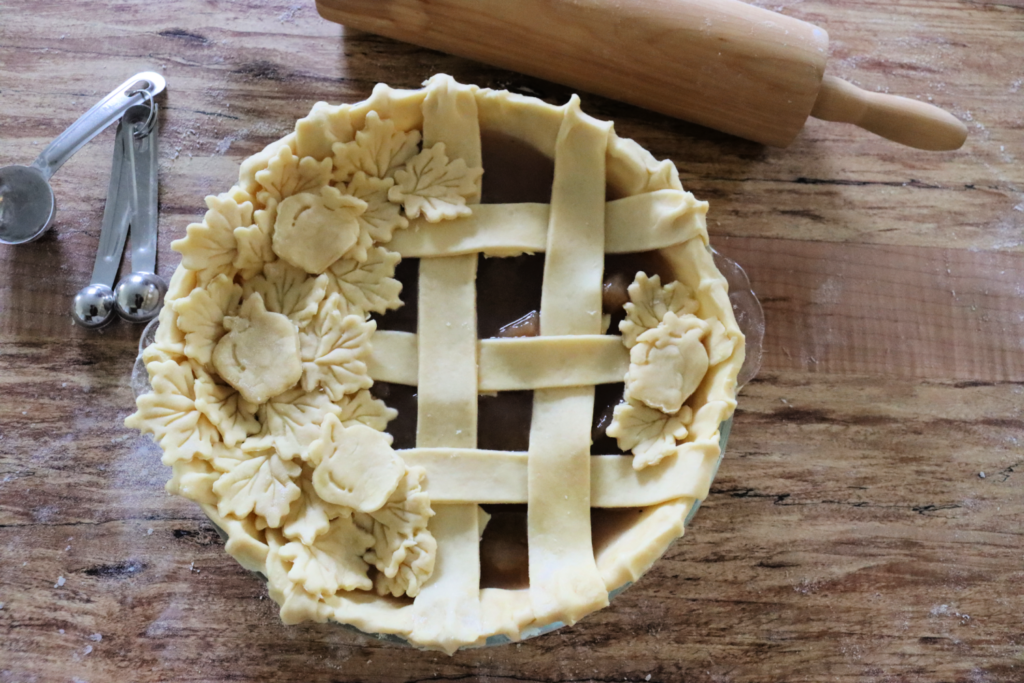
What flour is best for my pie crust?
All-purpose will give you a great texture as well as pastry flour. I wouldnt use bread flour, you dont need the extra gluten for pie crust.
For fresh ground flour choices, I use a blend of fresh ground spelt and soft white wheat on the pastry setting of my flour grinder. Learn more on grinding your own flour and choosing a grinder here.
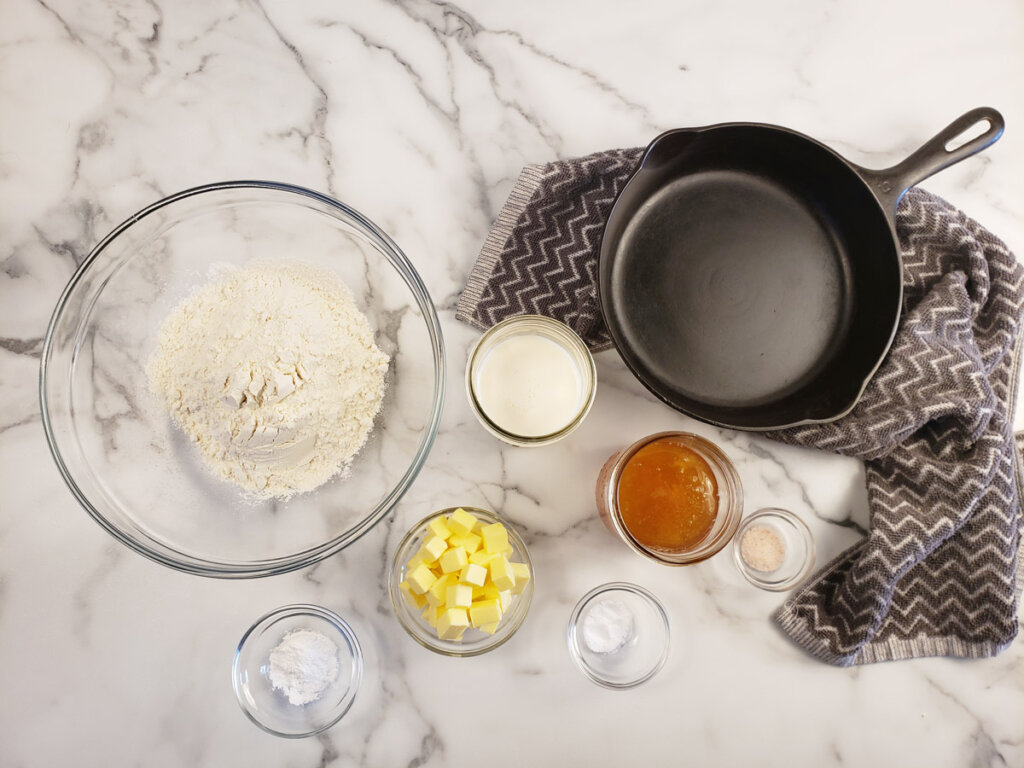
Great-grandma knew a thing or two about baking and one of those was the addition of two special ingredients not always found in common pie crust recipes. These two items make this a foolproof pie crust with the addition of vinegar and egg!
I know, the vinegar may throw you, but trust me, together, they make a world of difference in both the flakiness and ease of working with the dough, and you wont taste the vinegar one bit.
- Flour – you can use just about any flour you want for pie crust, however, I have the best, most consistent results when using all-purpose or pastry flour.
- Fat – no matter what fat youre using, its critical that the fat is cold! My preferred fat is butter (grass-fed, if possible), but you can also use lard (especially delicious if youve rendered your own lard), or coconut oil (perfect for a dairy-free option).
- Sugar – not too much, just enough to give your pie crust more of a dessert taste, rather than a savory taste. You can easily omit this, but Ive used this exact recipe even for savory dishes (hello homemade chicken pot pie!) and its great. I also like to sprinkle sugar over the pie crust before baking. It adds a delicious crunch and pop of sweetness with each bite.
- Salt – because salt = flavor, and flavor is imperative for a delicious crust!
- Vinegar – you can use any vinegar you have on hand (homemade fruit vinegar is great for baking). Since I always make our own homemade apple cider vinegar, its what I use most often.
- Egg – though not typically found in pie crust, the egg working together with the vinegar is what makes the fool-proof flaky layers!
- Ice Water – though water isnt typically listed as an ingredient, its important to mention that you need ICE-COLD water! Those flaky layers happen when the butter melts during the baking process, so you dont want the butter to melt into the dough BEFORE baking, otherwise… no flaky layers!
- Milk – we dont add milk to the pie crust itself, but just before baking, I like to brush the pie crust with milk, then sprinkle on some sugar. This helps the crust bake up perfectly golden-brown.
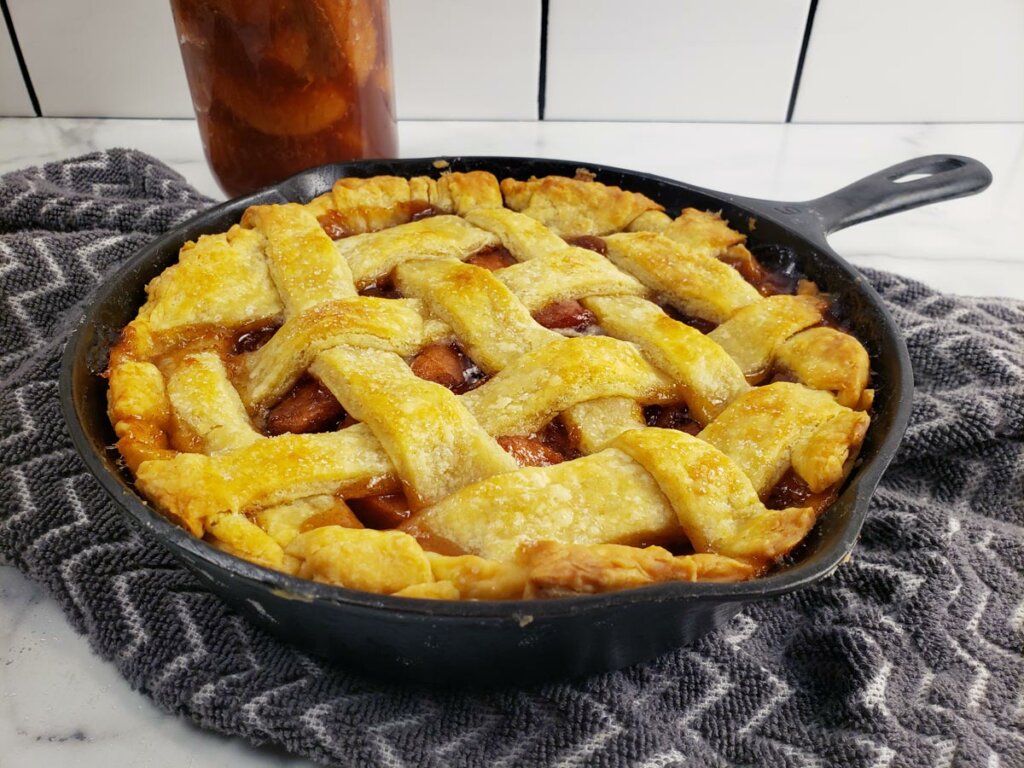
Measure out all ingredients and cut the butter into 1/2 inch cubes, then place the butter in the refrigerator or freezer until ready to use.
1. In a large bowl, combine flour, sugar, and salt and stir to combine.
2. Cut in cold butter using a pastry cutter until there are no pieces larger than the size of a pea.
3. In a small bowl, whisk together the apple cider vinegar and egg until combined, then add to the flour and butter mixture.
4. Add cold water, one tablespoon at a time, until dough just starts coming together, then turn out onto counter.
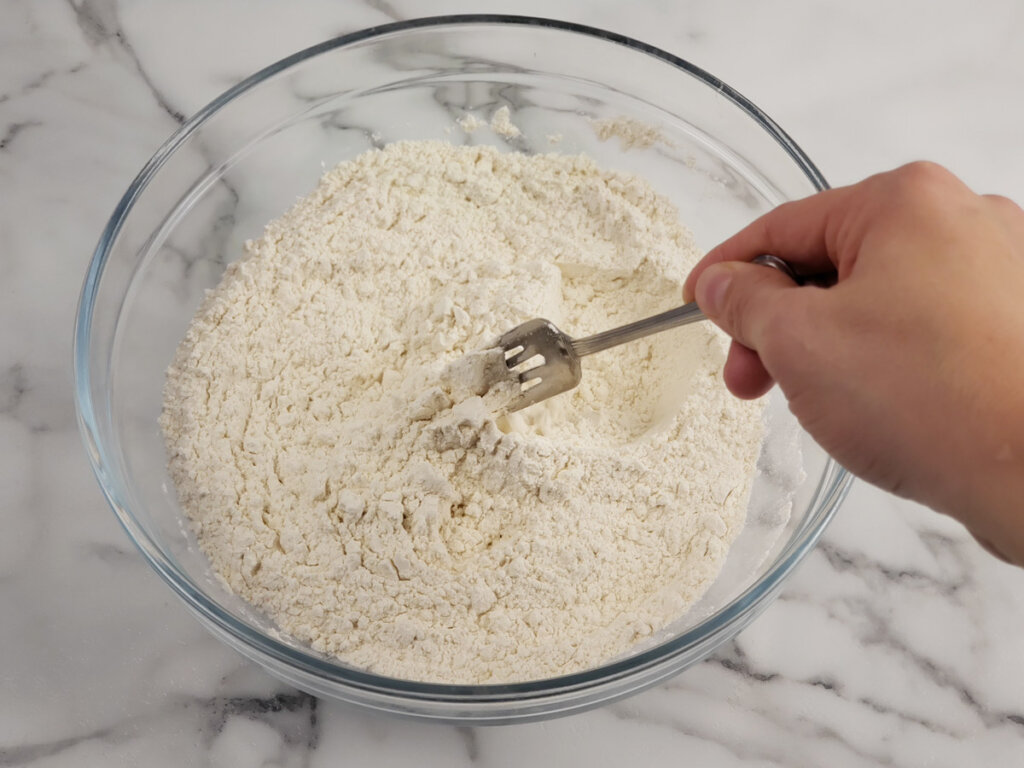
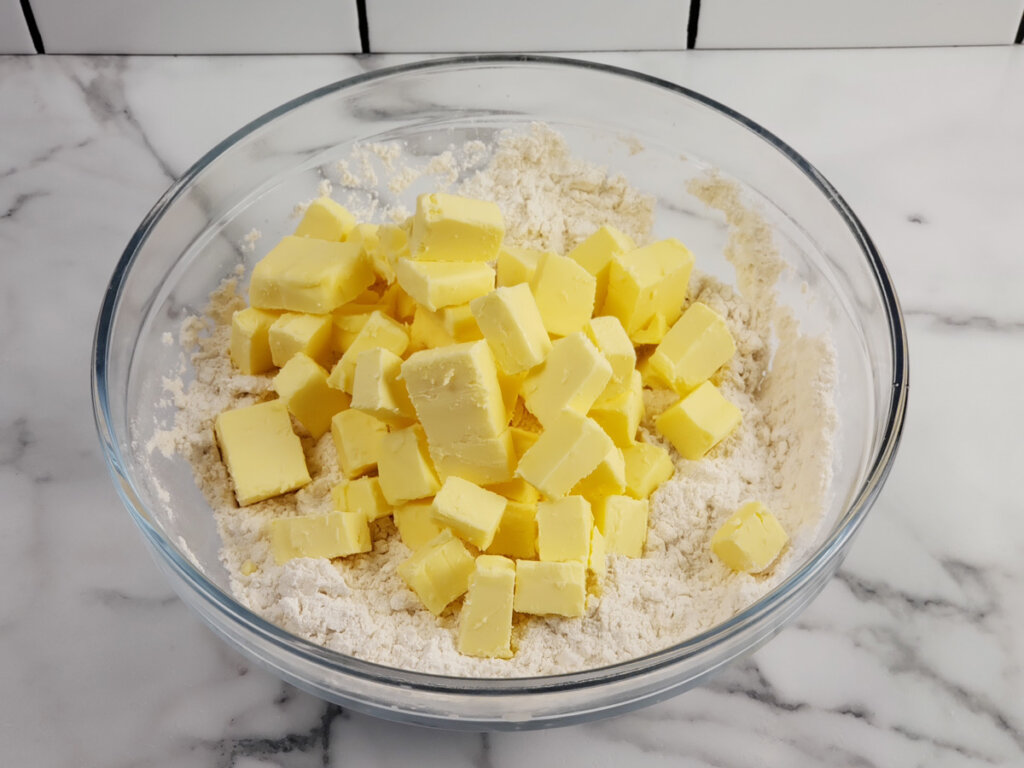

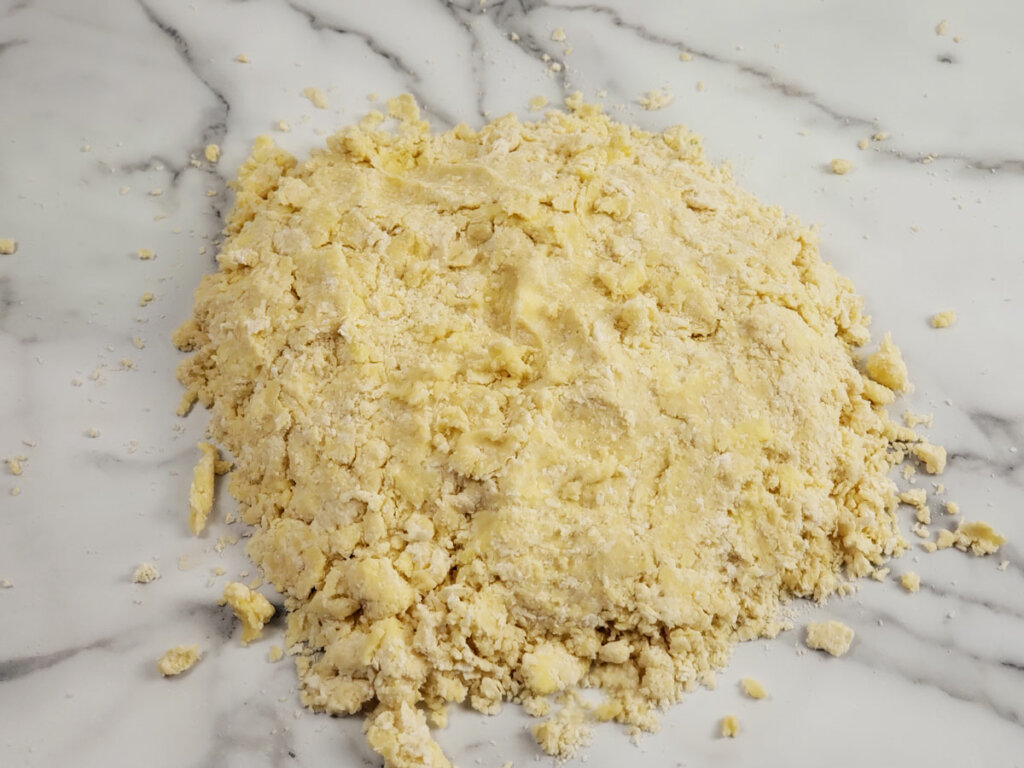
5. Continue adding 1 tablespoon of ice water until the dough holds its shape without crumbling. Dont add too much water, you dont want a sticky dough, just a dough that barely holds together.
6. Work the dough into a large round ball, cover with plastic wrap and refrigerate for 15 minutes to allow the dough to rest. (Dont skip this step!)
7. Once the dough has rested, remove it from the refrigerator and divide it into 4 equal portions. (I use my wooden bench knife for easy cutting. For more tips on using this indispensable tool, check out 10 Time-Saving Uses for a Wooden Bench Knife in the Kitchen.) Press each quarter into a disc shape, then, if freezing, follow the instructions in this post for how to freeze pie dough.
8. Working with one quarter at a time (keep the others in the refrigerator until ready to roll out), lightly dust your countertop and roll out pie crust, giving the dough a 1/4 turn after each roll to be sure its not sticking to the counter.
If the dough starts sticking to your rolling pin, lightly dust the rolling pin with flour.
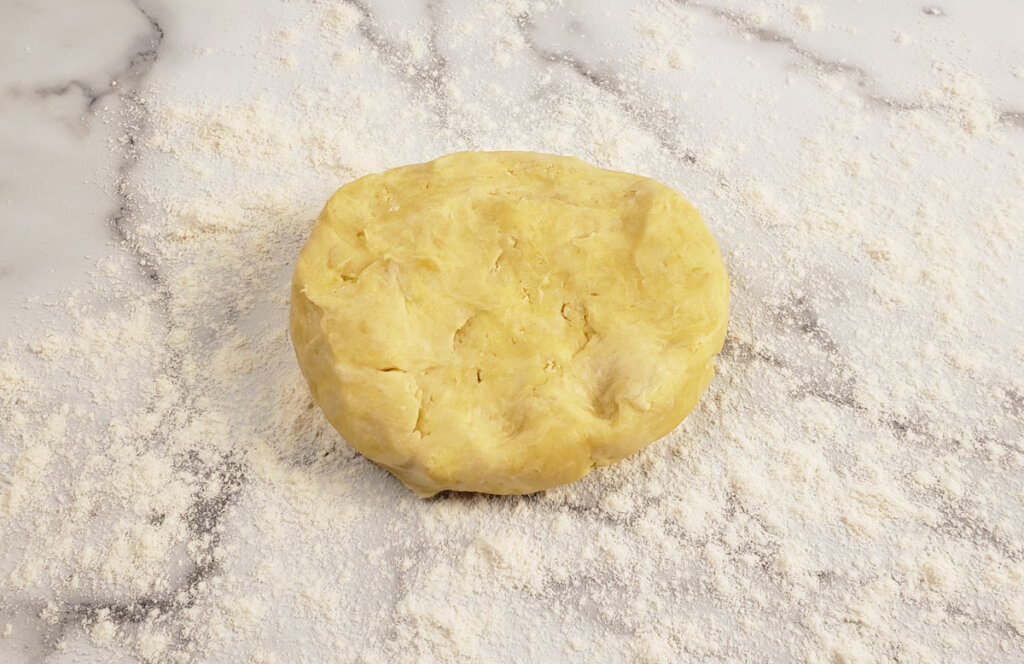
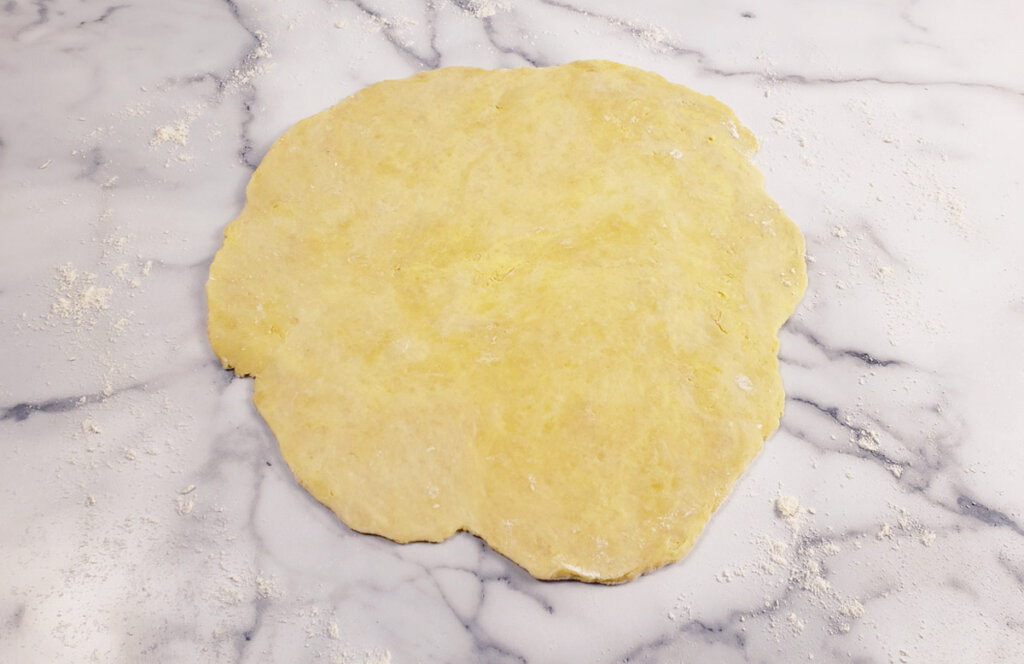
9. Carefully fold the dough over on itself and transfer it carefully to your favorite pie plate or cast iron skillet. Then, follow the instructions for your favorite pie or quiche recipe.
Easy All-Butter Pie Crust Without a Food Processor Recipe (No Shortening or Eggs Used!)
FAQ
What can you use in pie crust instead of shortening?
Margarine and butter can both be used as a substitute for shortening, though their moisture contents should be taken into consideration before making the swap. While shortening is 100% fat, margarine and butter contain a small percentage of water (so, shortening adds more fat, thus more richness and tenderness).
Is shortening necessary for pie crust?
All things being equal,” she says, “there’s more fat per ounce of shortening than butter, and because shortening has a higher melting point than butter, it’s more forgiving to work with, so it might give the appearance of more tenderness.” But any pie crust should have enough fat, no matter the source, to produce a …
Can I use melted butter to make pie crust?
With melted butter, your pie crust will be thicker, sturdier, and reminiscent of shortbread cookies: tender, buttery, and flavorful. A melted butter pie crust is a close cousin to Hot Water Pastry, but with some added sugar (for flavor) and a touch of baking powder (for a lighter texture).
Can you substitute butter for shortening in pie?
No matter what you’re using, use the same amount called for in your recipe. In other words, it should be a one-to-one swap. If your recipe calls for one cup of butter, you can use one cup of shortening and vice versa.Feb 14, 2023
